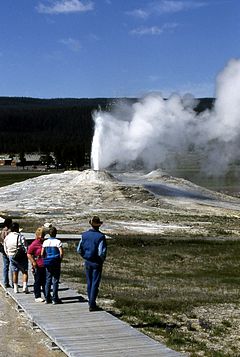Lion Geyser
Today, Lion Geyser is a topic that has gained great relevance in various areas of society. Since its emergence, Lion Geyser has caught the attention of many people due to its importance today. Over time, Lion Geyser has been the subject of debate, research and analysis, which has generated growing interest in its study. In this article, we will explore different aspects related to Lion Geyser, with the aim of offering a comprehensive view on this topic that is so relevant today. From its origins to its current implications, we will analyze all the relevant aspects to understand the importance of Lion Geyser in today's society.
| Lion Geyser | |
|---|---|
 Eruption, 1987 | |
 | |
| Location | Upper Geyser Basin, Yellowstone National Park, Teton County, Wyoming |
| Coordinates | 44°27′50″N 110°49′51″W / 44.4640243°N 110.8309603°W |
| Elevation | 7,405 feet (2,257 m) |
| Type | Cone geyser |
| Eruption height | 90 feet (27 m) |
| Duration | 7 minutes |
| Temperature | 92.1 °C (197.8 °F) |
Lion Geyser is a cone-type geyser in the Upper Geyser Basin of Yellowstone National Park in the United States. It is located in the Geyser Hill complex.
It was named for the roaring sound of steam releasing during an eruption. Eruptions can reach 90 feet (27 m) and last from 1 to 7 minutes. Lion is the largest of the Lion Group which includes Little Cub Geyser and the currently inactive Big Cub and Lioness geysers.
References
- ^ a b "Lion Geyser". Yellowstone Geothermal Features Database. Montana State University.
- ^ "Lion Geyser". Geographic Names Information System. United States Geological Survey, United States Department of the Interior.
- ^ "Geyser Hill". Geyser Observation and Study Association. Archived from the original on 2010-11-29. Retrieved 2010-11-11.
- ^ "Lion Geyser". Geyser Observation and Study Association.
- ^ "Lion Group of Geysers". National Park Service.


